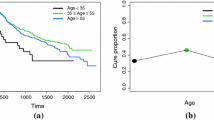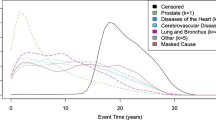Abstract
Due to the fact that certain fraction of the population suffering a particular type of disease get cured because of advanced medical treatment and health care system, we develop a general class of models to incorporate a cure fraction by introducing the latent number N of metastatic-competent tumor cells or infected cells caused by bacteria or viral infection and the latent antibody level R of immune system. Various properties of the proposed models are carefully examined and a Markov chain Monte Carlo sampling algorithm is developed for carrying out Bayesian computation for model fitting and comparison. A real data set from a prostate cancer clinical trial is analyzed in detail to demonstrate the proposed methodology.
Similar content being viewed by others
References
Berkson J, Gage RP (1952) Survival curve for cancer patients following treatment. J Am Stat Assoc 47: 501–515
Broet P, Rycke YD, Tubert-Bitter P, Lellouch J, Asselain B, Moreau T (2001) A semiparametric approach for the two-sample comparison of survival times with long-term survivors. Biometrics 57: 844–852
Chen M-H, Ibrahim JG (2001a) Maximum likelihood methods for cure rate models with missing covariates. Biometrics 57: 43–52
Chen M-H, Ibrahim JG (2001b) Bayesian model comparisons for survival data with a cure fraction. In: Bayesian methods with applications to science, policy and official statistics. Office for Official Publications of the European Communities, Luxembourg, pp 81–90
Chen M-H, Ibrahim JG, Sinha D (1999) A new Bayesian model for survival data with a surviving fraction. J Am Stat Assoc 94: 909–919
Chen M-H, Ibrahim JG, Sinha D (2002a) Bayesian inference for multivariate survival data with a surviving fraction. J Multivar Anal 80: 101–126
Chen M-H, Harrington DP, Ibrahim JG (2002b) Bayesian cure rate models for malignant melanoma: a case-study of Eastern Cooperative Oncology Group Trial E1690. Appl Stat 51(2): 135–150
Cheng SC, Wei LJ, Ying Z (1995) Analysis of transformation models with censored data. Biometrika 82: 835–845
Chi Y, Ibrahim JG (2006) Joint models for multivariate longitudinal and multivariate survival data. Biometrics 62: 432–445
Clayton DG, Cuzick J (1986) The semi-parametric pareto model for regression analysis of survival times. In: Gill RD, Voors MN (eds) Papers on semiparametric models at the ISI centenary session, Report MS-R8169. Centre for Mathematics and Computer Science, Amsterdam, pp 19–30
Cooner F, Banerjee S, Carlin BP, Sinha D (2007) Flexible cure rate modelling under latent activation schemes. J Am Stat Assoc 102: 560–572
Cooner FW, Yu X, Banerjee S, Grambsch PL, McBean AM (2009) Hierarchical dynamic time-to-event models for post-treatment preventive care data on breast cancer survivors. Stat Modell 9: 119–135
Cowles MK, Carlin BP (1996) Markov chain Monte Carlo convergence diagnostics: A comparative review. J Am Stat Assoc 91: 883–904
Cox DR (1972) Regression models and life tables. J R Stat Soc Series B 34: 187–220
Cuzick J (1988) Rank regression. Ann Stat 16: 1369–1389
D’Amico AV, Renshaw AA, Sussman B, Chen M-H (2005) Pre-treatment PSA velocity and the risk of death from prostate cancer following external beam radiation therapy. J Am Med Assoc 294: 440–447
Farewell VT (1982) The use of mixture models for the analysis of survival data with long-term survivors. Biometrics 38: 1041–1046
Farewell VT (1986) Mixture models in survival analysis: are they worth the risk?. Can J Stat 14: 257–262
Fine JP (1999) Analysing competing risks data with transformation models. J R Stat Soc Series B 61: 817–830
Gilks WR, Wild P (1992) Adaptive rejection sampling for Gibbs sampling. Appl Stat 41: 337–348
Hastings WK (1970) Monte Carlo sampling methods using Markov chains and their applications. Biometrika 57: 97–109
Ibrahim JG, Chen M-H, Sinha D (2001a) Bayesian semi-parametric models for survival data with a cure fraction. Biometrics 57: 383–388
Ibrahim JG, Chen M-H, Sinha D (2001b) Bayesian survival analysis. Springer-Verlag, New York
Ibrahim JG, Chen M-H, Sinha D (2005) Bayesian approaches to cure rate models. In: Armitage P, Colton T (eds) Encyclopedia of Biostatistics, 2nd edn, vol 1. Wiley, Chichester, pp 306–313
Kim S, Chen M-H, Dey DK, Gamerman D (2007) Bayesian dynamic models for survival data with a cure fraction. Lifetime Data Anal 13: 17–35
Kim S, Xi Y, Chen M-H (2009) A new latent cure rate marker model for survival data. Ann Appl Stat 3: 1124–1146
Kuk AYC, Chen C-H (1992) A mixture model combining logistic regression with proportional hazards regression. Biometrika 79: 531–541
Li C-S, Taylor JMG, Sy JP (2001) Identifiability of cure models. Stat Probab Lett 54: 389–395
Liu JS (1994) The collapsed Gibbs sampler in Bayesian computations with applications to a gene regulation problem. J Am Stat Assoc 89: 958–966
Lu W, Ying Z (2004) On semiparametric transformation cure models. Biometrika 91: 331–343
Maller R, Zhou X (1996) Survival analysis with long-term survivors. Wiley, New York
Meeker WQ (1987) Limited failure population life tests: application to integrated circuit reliability. Technometrics 29: 51–65
Peng Y, Dear KBG (2000) A nonparametric mixture model for cure rate estimation. Biometrics 56: 237–243
Spiegelhalter DJ, Best NG, Carlin BP, van der Linde A (2002) Bayesian measures of model complexity and fit (with discussion). J R Stat Soc Series B 64: 583–639
Sy JP, Taylor JMG (2000) Estimation in a proportional hazards cure model. Biometrics 56: 227–336
Tsodikov A (2001) Estimation of survival based on proportional hazards when cure is a possibility. Math Comput Model 33: 1227–1236
Tsodikov A (2002) Semiparametric models of long- and short-term survival: an application to the analysis of breast cancer survival in Utah by age and stage. Stat Med 21: 895–920
Tsodikov AD, Ibrahim JG, Yakovlev AY (2003) Estimating cure rates from survival data: an alternative to two-component mixture models. J Am Stat Assoc 98: 1063–1078
Yakovlev AY, Tsodikov AD (1996) Stochastic models of tumor latency and their biostatistical applications. World Scientific, New Jersey
Yakovlev AY, Asselain B, Bardou VJ, Fourquet A, Hoang T, Rochefediere A, Tsodikov AD (1993) A simple stochastic model of tumor recurrence and its applications to data on premenopausal breast cancer. In: Asselain B, Boniface M, Duby C, Lopez C, Masson JP, Tranchefort J (eds) Biometrie et Analyse de Dormees Spatio-Temporelles, 12. Société Francaise de Biométrie, ENSA Rennes, France, pp 66–82
Yin G, Ibrahim JG (2005a) A general class of Bayesian survival models with zero and nonzero cure fractions. Biometrics 61: 403–412
Yin G, Ibrahim JG (2005b) Cure rate models: a unified approach. Can J Stat 33: 559–570
Author information
Authors and Affiliations
Corresponding author
Rights and permissions
About this article
Cite this article
Kim, S., Chen, MH. & Dey, D.K. A new threshold regression model for survival data with a cure fraction. Lifetime Data Anal 17, 101–122 (2011). https://doi.org/10.1007/s10985-010-9166-9
Received:
Accepted:
Published:
Issue Date:
DOI: https://doi.org/10.1007/s10985-010-9166-9




